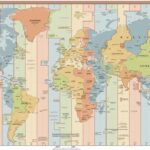Comparative advantage is a foundational concept in economics, and COMPARE.EDU.VN is here to dissect its meaning, application, and benefits in today’s globalized world. This article delves into the comparative advantage meaning, exploring its nuances and how it drives international trade and economic growth, offering a clear understanding of its principles and real-world implications, including opportunity cost and efficient resource allocation, ensuring you grasp its significance in economic decision-making.
1. Defining Comparative Advantage
The comparative advantage meaning lies in a nation’s ability to produce a good or service at a lower opportunity cost than its competitors. This isn’t about who can produce more (absolute advantage), but about who sacrifices less in terms of alternative production. To truly understand this concept, it is essential to have solid grasp of opportunity cost which is potential benefit that someone loses out on when selecting a particular option over another.
1.1. Opportunity Cost: The Key to Comparative Advantage
Opportunity cost is the bedrock of comparative advantage. It represents the potential benefits a company or individual misses out on when choosing one option over another. The entity with the lower opportunity cost possesses the comparative advantage.
For instance, imagine two countries, A and B, both capable of producing wheat and textiles. If Country A can produce a ton of wheat by foregoing the production of 100 meters of textiles, while Country B must forego 150 meters of textiles for the same ton of wheat, Country A has a comparative advantage in wheat production. Their opportunity cost is lower.
1.2. Comparative Advantage vs. Absolute Advantage
It’s crucial to differentiate comparative advantage from absolute advantage. Absolute advantage signifies the ability to produce more of a good or service using the same resources. A country can have an absolute advantage in multiple sectors, but it can only have a comparative advantage in those where its opportunity cost is lowest.
Consider a lawyer who’s also a fast typist. They have an absolute advantage in both legal services and typing. However, their time is much more valuable spent practicing law. Hiring a secretary to handle typing allows the lawyer to focus on higher-paying legal work, illustrating the principle of comparative advantage.
:max_bytes(150000):strip_icc()/comparative-advantage-4199071-04ccb37cbf71441ea5264d2c07a48fab.png)
1.3. Dynamic Comparative Advantage
While traditional comparative advantage focuses on inherent resource endowments, dynamic comparative advantage considers how countries can develop new advantages through investment in education, technology, and infrastructure. This means a country initially lacking a comparative advantage in a particular industry can cultivate one over time.
2. The Importance of Comparative Advantage in International Trade
Comparative advantage is a cornerstone of international trade theory. It explains why countries benefit from specializing in producing goods and services where they have a relative advantage and trading with others for what they can’t produce as efficiently.
2.1. Specialization and Efficiency
By focusing on their comparative advantages, countries can increase their overall production efficiency. Resources are allocated to their most productive uses, leading to higher output and lower costs. This specialization fosters economic growth and raises living standards.
2.2. Gains from Trade
International trade based on comparative advantage allows countries to consume beyond their production possibilities. By exporting goods they produce efficiently and importing goods that are costly to produce domestically, countries can access a wider variety of goods and services at lower prices.
2.3. The Role of Free Trade
The theory of comparative advantage underpins the argument for free trade. When countries can freely trade goods and services, resources flow to their most productive uses globally, maximizing overall economic welfare. This fosters competition, innovation, and economic growth.
3. Examples of Comparative Advantage in the Real World
Comparative advantage is not just a theoretical concept; it’s evident in the patterns of international trade we see every day.
3.1. China and Manufacturing
China’s comparative advantage in labor-intensive manufacturing has made it the world’s leading exporter of goods like clothing, electronics, and toys. Its large workforce and relatively low labor costs allow it to produce these goods at a lower opportunity cost than many other countries.
3.2. United States and Technology
The United States, with its strong research and development capabilities and skilled workforce, holds a comparative advantage in technology and innovation. It exports high-tech products and services like software, pharmaceuticals, and financial services.
3.3. Brazil and Agriculture
Brazil’s abundant land and favorable climate give it a comparative advantage in agriculture. It’s a major exporter of commodities like soybeans, coffee, and sugar.
4. Criticisms and Limitations of Comparative Advantage
Despite its widespread acceptance, the theory of comparative advantage has faced criticism.
4.1. Assumptions of Perfect Competition
The theory assumes perfect competition, which rarely exists in the real world. Market imperfections like monopolies, externalities, and information asymmetry can distort trade patterns and undermine the benefits of comparative advantage.
4.2. Static Analysis
The traditional theory is static, focusing on a snapshot in time. It doesn’t adequately account for the dynamic changes that can occur in technology, consumer preferences, and government policies.
4.3. Exploitation of Labor and Resources
Critics argue that comparative advantage can lead to the exploitation of labor and natural resources in developing countries. Companies may seek to lower costs by taking advantage of weak labor laws and environmental regulations.
4.4. Rent Seeking
Rent-seeking behavior, where groups lobby the government to protect their interests, can undermine the benefits of comparative advantage. For example, domestic industries may lobby for tariffs or quotas to protect themselves from foreign competition, even if this reduces overall economic welfare.
5. Comparative Advantage vs. Competitive Advantage
While related, comparative advantage and competitive advantage are distinct concepts. Competitive advantage refers to a company, economy, country, or individual’s ability to provide a stronger value to consumers as compared with its competitors.
5.1. Competitive Advantage: Gaining Market Share
Competitive advantage focuses on factors that allow a business to outperform its rivals, such as lower costs, superior products, or better customer service. A company might achieve a competitive advantage through innovation, branding, or strategic alliances.
5.2. Interplay of Both Advantages
Comparative advantage provides a foundation for competitive advantage. A country with a comparative advantage in a particular industry can foster the development of firms with a competitive advantage in that industry.
6. Advantages and Disadvantages of Comparative Advantage
As with any economic concept, comparative advantage has both pros and cons.
6.1. Advantages
- Increased Efficiency: Resources are allocated to their most productive uses.
- Lower Costs: Production costs are reduced through specialization.
- Greater Variety: Consumers have access to a wider range of goods and services.
- Economic Growth: Specialization and trade foster innovation and growth.
6.2. Disadvantages
- Dependence on Trade: Countries may become overly reliant on foreign markets.
- Vulnerability to Shocks: Global events can disrupt trade patterns and harm economies.
- Income Inequality: Benefits of trade may not be evenly distributed.
- Environmental Degradation: Over-specialization can lead to resource depletion and pollution.
| Advantages | Disadvantages |
|---|---|
| Increased Efficiency | Dependence on Trade |
| Lower Costs | Vulnerability to Shocks |
| Greater Variety | Income Inequality |
| Economic Growth | Environmental Degradation |
7. Calculating Comparative Advantage: A Practical Approach
While the concept is clear, how do you actually calculate comparative advantage? Here’s a practical approach:
7.1. Determining Opportunity Costs
First, determine the opportunity cost for each entity (country, company, individual) for producing each good or service. This involves figuring out how much of one good must be sacrificed to produce another.
7.2. Comparing Opportunity Costs
Compare the opportunity costs across entities for each good or service. The entity with the lower opportunity cost has the comparative advantage.
7.3. Example Calculation
Let’s say Country A can produce 10 tons of steel or 20 tons of wheat with its resources. Country B can produce 5 tons of steel or 15 tons of wheat.
- Country A’s Opportunity Costs:
- 1 ton of steel = 2 tons of wheat
- 1 ton of wheat = 0.5 tons of steel
- Country B’s Opportunity Costs:
- 1 ton of steel = 3 tons of wheat
- 1 ton of wheat = 0.33 tons of steel
Country A has a lower opportunity cost for producing steel (2 tons of wheat vs. 3 tons for Country B), while Country B has a lower opportunity cost for producing wheat (0.33 tons of steel vs. 0.5 tons for Country A). Therefore, Country A has a comparative advantage in steel, and Country B has a comparative advantage in wheat.
8. The Role of Technology and Innovation
Technology and innovation are constantly reshaping comparative advantage.
8.1. Automation and Robotics
Automation and robotics can reduce labor costs and increase productivity, potentially shifting comparative advantages away from countries with cheap labor.
8.2. Digital Technologies
Digital technologies like artificial intelligence and the Internet of Things are creating new opportunities for innovation and specialization, leading to new comparative advantages.
8.3. Reshoring and Nearshoring
Advanced manufacturing technologies are enabling companies to bring production back to developed countries (reshoring) or to nearby countries (nearshoring), reducing reliance on distant suppliers.
9. Comparative Advantage in Personal Finance and Career Planning
The principle of comparative advantage extends beyond international trade; it can also guide personal finance and career planning.
9.1. Focusing on Strengths
Identify your skills and talents and focus on activities where you have a comparative advantage. This might mean pursuing a particular career path, outsourcing tasks you’re not good at, or investing in education and training to develop new skills.
9.2. Outsourcing and Delegation
Just as countries benefit from trade, individuals can benefit from outsourcing tasks to others. If you’re not good at bookkeeping, hire an accountant. If you dislike yard work, hire a landscaper. This allows you to focus on activities where you’re most productive and valuable.
 Welder working
Welder working
9.3. Investing in Education and Training
Investing in education and training can help you develop new skills and enhance your comparative advantage. Choose fields where you have a passion and aptitude, and where there’s strong demand for your skills.
10. Future Trends and the Evolution of Comparative Advantage
The future of comparative advantage is likely to be shaped by several key trends.
10.1. Rise of Services Trade
As economies become more service-oriented, trade in services will become increasingly important. Countries with strong service sectors, such as the United States and the United Kingdom, will have a comparative advantage in this area.
10.2. Importance of Data and Intellectual Property
Data and intellectual property are becoming increasingly valuable assets. Countries with strong data infrastructure and robust intellectual property protection will have a comparative advantage in the digital economy.
10.3. Focus on Sustainability
As environmental concerns grow, sustainability will become a key factor in determining comparative advantage. Countries with strong environmental regulations and a focus on green technologies will be well-positioned to compete in the future.
11. How to Leverage Comparative Advantage for Business Success
Understanding comparative advantage is crucial for businesses seeking to thrive in a globalized marketplace.
11.1. Identifying Core Competencies
Businesses should identify their core competencies – the activities they perform exceptionally well and that provide a competitive edge. These competencies often align with the country’s comparative advantages.
11.2. Global Sourcing and Supply Chains
Businesses can leverage global sourcing and supply chains to access lower-cost inputs and specialized expertise. This involves identifying countries with a comparative advantage in producing specific components or services.
11.3. Market Selection and Expansion
When expanding into new markets, businesses should consider the comparative advantages of different countries. Focus on markets where your products or services are likely to be in high demand and where competition is less intense.
12. Case Studies: Countries and Industries That Have Successfully Leveraged Comparative Advantage
Several countries and industries have successfully leveraged comparative advantage to achieve economic success.
12.1. Singapore: A Hub for Trade and Finance
Singapore has transformed itself into a major hub for trade and finance by leveraging its strategic location, strong institutions, and skilled workforce. It has a comparative advantage in logistics, financial services, and high-tech manufacturing.
12.2. Germany: Engineering and Manufacturing Excellence
Germany is renowned for its engineering and manufacturing prowess. It has a comparative advantage in producing high-quality machinery, automobiles, and chemicals.
12.3. South Korea: Innovation and Technology
South Korea has emerged as a leader in innovation and technology, with a comparative advantage in electronics, semiconductors, and automobiles.
13. Common Misconceptions About Comparative Advantage
There are several common misconceptions about comparative advantage.
13.1. It Only Applies to Countries
Comparative advantage applies to individuals, companies, and regions as well as countries.
13.2. It Means Producing Everything Domestically
Comparative advantage encourages specialization and trade, not self-sufficiency.
13.3. It’s Always Static
Comparative advantage can change over time due to technological advancements, policy changes, and other factors.
14. The Impact of Government Policies on Comparative Advantage
Government policies play a significant role in shaping comparative advantage.
14.1. Education and Training
Investing in education and training can enhance a country’s human capital and create a comparative advantage in knowledge-intensive industries.
14.2. Infrastructure Development
Developing infrastructure, such as transportation networks and communication systems, can lower transportation costs and facilitate trade.
14.3. Trade Policies
Trade policies, such as tariffs and quotas, can distort trade patterns and undermine the benefits of comparative advantage.
15. How Comparative Advantage Affects Global Supply Chains
Comparative advantage is a key driver of global supply chains.
15.1. Sourcing Decisions
Companies make sourcing decisions based on the comparative advantages of different countries, seeking to minimize costs and maximize efficiency.
15.2. Production Fragmentation
Production processes are often fragmented across multiple countries, with each country specializing in the activities where it has a comparative advantage.
15.3. Supply Chain Resilience
Global supply chains can be vulnerable to disruptions, such as natural disasters and political instability. Companies are increasingly focusing on building more resilient supply chains by diversifying their sourcing and production locations.
16. Ethical Considerations in Leveraging Comparative Advantage
Leveraging comparative advantage raises ethical considerations.
16.1. Labor Standards
Companies should ensure that their suppliers adhere to fair labor standards and provide safe working conditions.
16.2. Environmental Sustainability
Companies should minimize their environmental impact and promote sustainable practices.
16.3. Corporate Social Responsibility
Companies should engage in corporate social responsibility initiatives to benefit the communities where they operate.
17. Expert Insights on the Future of Comparative Advantage
Experts believe that the future of comparative advantage will be shaped by several key trends.
17.1. Technological Disruption
Technological disruption will continue to reshape comparative advantage, creating new opportunities and challenges.
17.2. Geopolitical Shifts
Geopolitical shifts, such as trade wars and political instability, can disrupt global supply chains and alter trade patterns.
17.3. Focus on Inclusiveness
There will be a growing focus on ensuring that the benefits of comparative advantage are shared more inclusively.
18. Resources for Further Learning About Comparative Advantage
There are many resources available for further learning about comparative advantage.
18.1. Books and Articles
Numerous books and articles explore the theory and practice of comparative advantage.
18.2. Online Courses
Online courses offer a convenient way to learn about comparative advantage from experts in the field.
18.3. Economic Institutions
Economic institutions, such as the World Trade Organization and the International Monetary Fund, provide valuable data and analysis on international trade and comparative advantage.
19. FAQ About Comparative Advantage
1. What is the difference between comparative advantage and absolute advantage?
Comparative advantage is producing at a lower opportunity cost, while absolute advantage is producing more with the same resources.
2. How does comparative advantage benefit countries?
It allows countries to specialize, increase efficiency, and access a wider variety of goods through trade.
3. Can comparative advantage change over time?
Yes, due to technology, policy, and other factors.
4. What are the criticisms of comparative advantage?
It assumes perfect competition, can lead to exploitation, and may not address dynamic changes.
5. How do governments influence comparative advantage?
Through education, infrastructure, and trade policies.
6. How does technology affect comparative advantage?
Automation and digital technologies can shift advantages and create new opportunities.
7. What role does ethics play in comparative advantage?
Ensuring fair labor standards, environmental sustainability, and corporate social responsibility.
8. How can businesses leverage comparative advantage?
By identifying core competencies and optimizing global sourcing.
9. Is comparative advantage relevant to personal finance?
Yes, by focusing on strengths and outsourcing tasks where you don’t have an advantage.
10. What is the future of comparative advantage?
Technological disruption, geopolitical shifts, and a focus on inclusiveness.
20. Conclusion: Embracing Comparative Advantage for a Prosperous Future
Understanding the comparative advantage meaning is essential for informed decision-making in today’s interconnected world. By specializing in what they do best and engaging in trade, countries, businesses, and individuals can unlock new opportunities for prosperity. Visit COMPARE.EDU.VN to explore detailed comparisons, make informed choices, and discover the best paths to success.
Are you struggling to compare different products, services, or ideas? Do you need objective information to make informed decisions? Visit COMPARE.EDU.VN today and discover a wealth of comprehensive comparisons that can help you make the right choice. Our detailed analyses, pros and cons lists, and user reviews will empower you to confidently choose the best option for your needs and budget. Don’t let uncertainty hold you back—explore COMPARE.EDU.VN and make smarter decisions today!
For more information, please contact us at:
Address: 333 Comparison Plaza, Choice City, CA 90210, United States
Whatsapp: +1 (626) 555-9090
Website: compare.edu.vn

